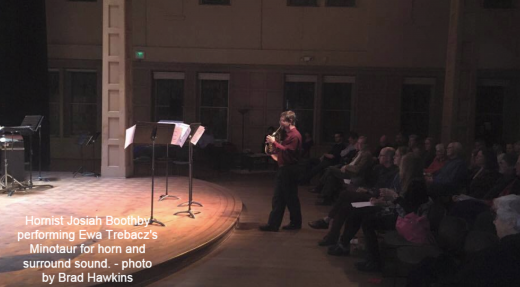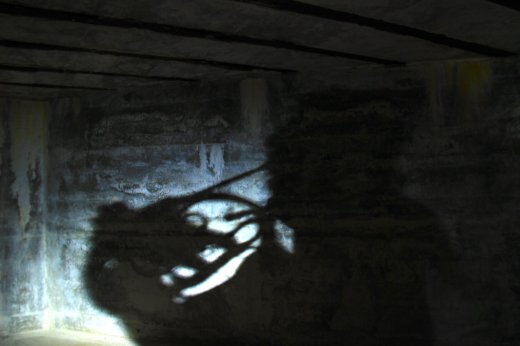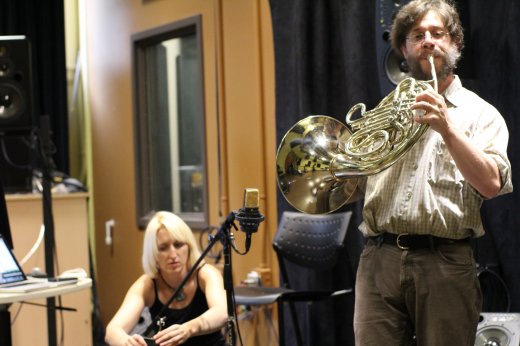|
NOTES FOR SOLOISTS
Each performance is unique.
- Different skills sets of each performer, exposed in various acoustic environments, create dramatic differences between performances and recordings of "Minotaur".
- The soloist is given a lot of freedom in choosing ways to interact with the pre-recorded soundscapes and the material written in the score. Several decisions on how to apply ornamentation, articulation and right-hand coloration make each performance absolutely unique.
Explore the space!
- If possible, spend some time improvising freely, perhaps as part of a warm-up routine, in the space. Find musical ideas that particularly fit the hall.
- If possible, I would like to encourage you to explore the entire hall or performance space.
- While performing the piece, you could try walking through the space, looking for acoustically interesting spots other than the stage.
- At times you could become invisible, haunting the perimeter of the audience and even leaving the area enclosed by the speaker array.
- If the space does not allow this kind of exploration, the piece should be performed on stage, but with stage lights down or dimmed.
"Minotaur"must be memorized.
- No score is allowed on stage, especially if you decide to walk around the space and between the audience. It needs to be in your head and in your heart.
- After listening to the tape part itself, you will notice that the written score is a rough transcription of selected fragments of the TAPE part.
- For practicing purposes, the piece has been divided into 10 sections. Each section corresponds to a track on a "Practice CD" or its mp3 equivalent.
|

Josiah Boothby walking around the audience in the dark during his performance of Minotaur at Seattle Modern Orchestra Benefit Concert in 2016.
|
|
PREPARATION
Step 1. Memorize the TAPE part.
- Allow yourself enough time to get familiar with the tape part.
- Listen carefully to the tape only, several times BEFORE you even start looking at the score.
Step 2. Learn and memorize the score and try to play along with the tape.
- First, learn the notes, while listening to the TAPE.
- After this, try matching various motives with the TAPE, the way you like and enjoy.
Step 3. Once you are familiar with the tape and the score, you can start working on the piece.
- Motifs and phrases from the score can be repeated. You can skip certain parts if you wish and repeat others.
- Treat the score only as the starting point. Do not allow yourself to be a slave of the written notes! Play along and play around these notes while carefully listening to the TAPE and the performance space.
- Take your time and listen to the response of acoustic spaces you're in. Listen to how the TAPE sounds in these spaces and create various responses to the TAPE and the space.
- Remember you don't need to play all the time and all of the notes written in the score. Give your audience time to listen to the pre-recorded sounscapes alone and to listen to all the resonances of the performance space.
- Utilize right hand coloration:
- Modify the timbre of every note at will.
- Vary articulation and dynamics.
- Feel free to add ornamentation and color whenever you find it desirable.
- Enrich the written material with microtonal deviations. Stay "out of tune" with the TAPE part and enjoy the coloration that would emerge from creating such dissonances.
- Listen to the space around you - it will guide your choices.
|

|
|
TECHNICAL NOTES
Reverberation and optional live processing
- The tape is very reverberant. If the acoustics of the performance hall are very dry, there would be too much disparity between the tape part and the live horn sound. It may be necessary to compensate for this by processing the horn and adding slight amounts of reverb. However, it should be a priority to preserve the directionality of sound coming from the live performance.
NEVER apply any additional reverberation to the tape part.
Sound formats and downloads
- Audio files for "Minotaur" in various surround sound formats are available for download
- If none of the provided formats works for your speaker configuration, please email me and I will render a version that works best for your sound system.
- If you decide to use the provided B-format version (FOA), please be aware that reproducing B-format soundfiles requires the use of an Ambisonic decoder and a custom speaker setup. There are several Ambisonic decoders available free of charge. I highly recommend using the ATK plugins for Reaper or Super Collider.
|

Ewa Trębacz and Josiah Boothby rehearsing Minotaur at DXARTS, University of Washington.
|


